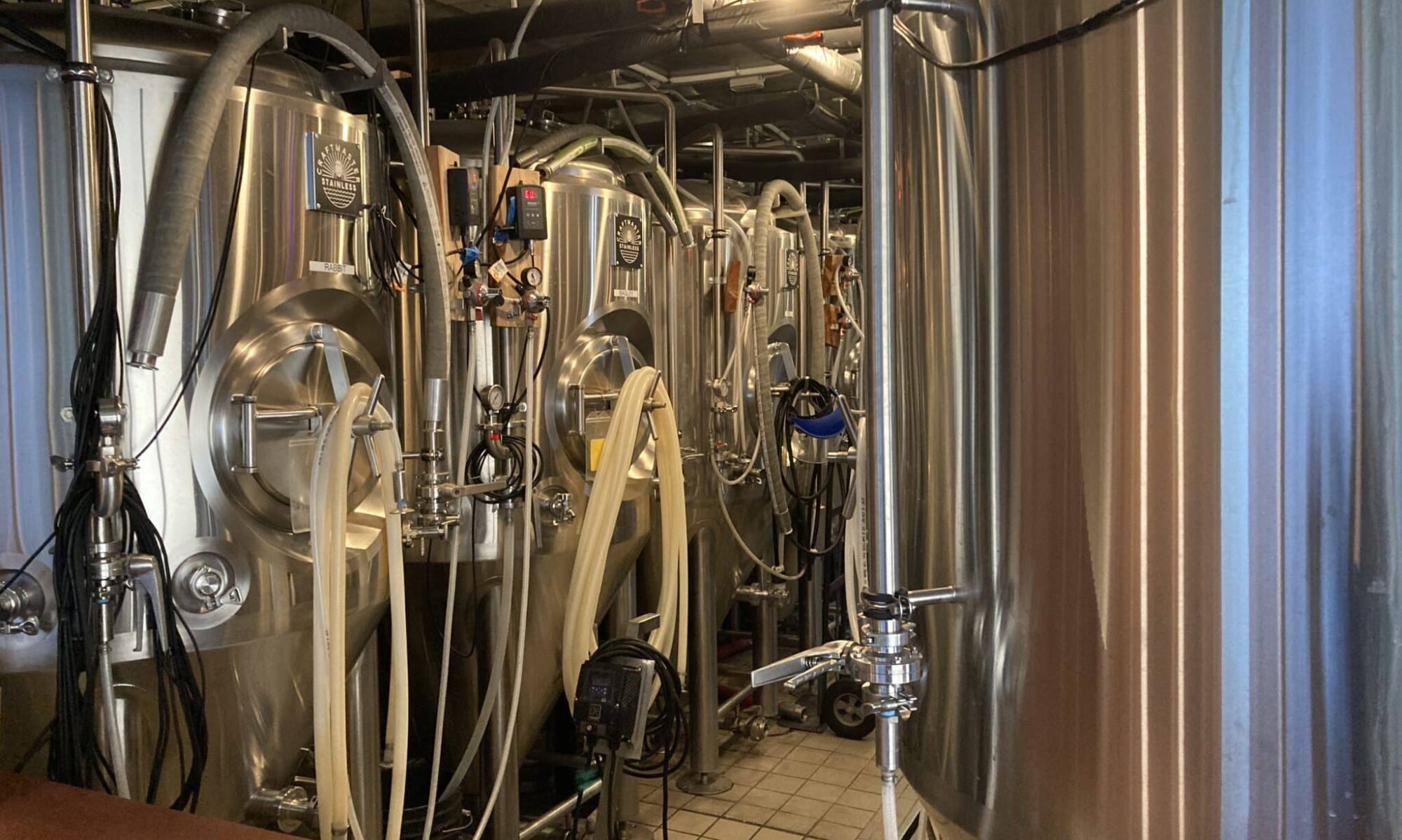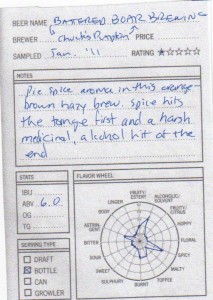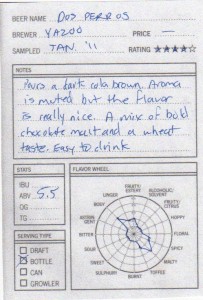Quite the wink-wink, nudge-nudge trailer but it could prove to have some interesting beer info…..
One week from today on the Discovery Channel. (Thanks to the Brookston Beer Bulletin for the heads-up!)

Follow Sean Inman to the best in craft beer
Quite the wink-wink, nudge-nudge trailer but it could prove to have some interesting beer info…..
One week from today on the Discovery Channel. (Thanks to the Brookston Beer Bulletin for the heads-up!)
This might be the first sighting of a new trend. St. Arnold started this series last year with Weed Whacker, a variant of the Fancy Lawnmower beer and in 2011 more moveavble yeasts will be made.
Here is the full list:
MOVABLE YEAST
Saint Arnold Brewing Co. pays homage to the hard-working fungi that turn sugar into alcohol with a series of familiar beers fermented with different strains of yeast. The first of these new, draft-only brews will be available at bars and restaurants across Texas next month. The brewer is making enough for approximately 20,000 12-ounce servings and expects that to last two to three weeks. A little about each beer:
• Weedwacker: A variation of Saint Arnold’s best-selling Fancy Lawnmower. All other ingredients remain the same, but the new beer will be fermented with a Bavarian hefeweizen yeast. Available Aug. 16.
• Altared Amber: The flagship beer will be made with Belgian Trappist yeast. Available mid-November.
• Bitter Belgian: Elissa IPA, also with Belgian Trappist yeast. Available mid-February.
• Brown Bitte: Brown Ale, with Alt yeast. Available mid-May.
The Portland brewery boom shows no sign of abating! Burnside Brewing just cracked open their doors and now another nano is moving forward with their brews!
“Beetje (\’bee-cha’\) is a Flemish word that roughly translates to “little”, or “little bit”. This brewery will live up to that notion for the foreseeable future.
Beetje will produce small batch beers using high quality ingredients. I intend to use organic 2-row and organic pilsner as my base malts. As much as possible I will use organic specialty malts, and hops. Sound familiar? Yeah, a lot of breweries do this, particularly in the Northwest. I like the approach, and intend to employ it. Quality inputs tend to have a positive impact on the beer”
And here are the beers you can try….
B-sideABV: 5.5% || IBU: 30
B-side is a light , crisp and refreshing farmhouse ale. Golden to light orange in color with a floral nose and a dry finish. B-side is brewed with three base malts: Organic Pilsner, Organic 2-row and Rye. Northwest grown Willamette, Golding and Hallertauer aroma hops offer a soft underlying bitterness to help bolster the refreshing nature of the beer. The key note speaker in this beer is the Farmhouse Ale yeast.
Traditionally farmhouse ales were brewed on farms in the French and Flemish regions of Belgium. These beers were born out of necessity as most water was not potable and the farmers needed a light, refreshing low alcohol beverage to offer the hardworking farmhands.
Little Brother
ABV: 8.5% || IBU: 20
Little Brother is in the vein of a Belgian dark strong ale. By Northwest standards an 8.5% beer may not be considered strong, but it is currently the biggest beer Beetje produces. It pours dark brown, with shades of ruby and a creamy tan head. The flavor is dominated by caramel, and candy and offers a smooth finish. Chocolate and coffee begin to emerge as the beer warms.
Flemish KissABV: 5.7% || IBU: 35-40
A clean Northwest pale ale with a subtle kiss of Flanders. Brewed predominantly with organic 2- row, the malt bill is rounded out with organic light munich, organic 60L crystal and caravienna. Northwest Golding and Hallertauer hops provide a pleasant hop character. Right out primary fermentation this beer is decidedly a Northwest pale ale, but as it enters secondary a bridge to Belgium is built with a dose of brettanomyces bruxellensis.
Check out other beers from Mountaineer Brewing Company HERE
SpeakEasy Night and the chance to go to the SF BEER WEEK!
Tonight, January 20 at 5:00pm at Blue Palms BrewHouse
“We will be serving Speakeasy beers and for every pint you have you will recieve a raffle ticket. We will be raffling off 2 Tickets to the Opening Gala and AirFare to SF BEER WEEK Opening Gala February 11. Cheers!!”
OK, I did not deliver on the promised Eagle Rock video reviews. They will have to be pushed to February. The reason being that I have a crapton (technical craft beer term) of beer from the Southeast of this fine brewing country and I could not rationalize buying more beer whilst staring into a full ‘fridge.
It’s a great problem to have though!
Instead here is a video of some beers from Tennessee, Yazoo Brewing and Smoky Mountain
Thanks to Ayn and Gev for doing the legwork (driving) to get me these brews!
If you are a science geek or you enjoy taking the beer tour and learning about the process of making beer then you should also enjoy the science of how we enjoy our beers.
Beer Sensory Science gets a little wonky at times but there is good information and nuggets of wisdom in each of the posts that I have read so far.
The tips for buying beer has some good information and learning about the “off” flavors is interesting too. Another good post has loads of descriptive adjectives that really can help the beer reviewer.
One word of caution, the posts tend towards the negative results. Not in a sky is falling way but in a slightly patronizing tone. Maybe it was just my interpretation but most people will not notice that oxidization in beer is rampant. The writer is a professional and has a palate that is much more attuned to nuance than mine and probably most people. If you don’t taste oxidization or diacetyl as much then count yourself blessed and keep drinking.
Is this a trend developing? English style session ales would be most welcome. Here is what the up and coming Oakshire from Oregon has in store….
“The most recent in our series of Single Batch Beers is a English Style Pale Ale called Willamette Dammit. The beer is made with 100% Crisp Marris Otter Pale malt and 100% Willamette Hops. Willamette hops are a relative of the English fuggle and were first bred in the Oregon Breeding Program in 1976. They are a very pleasant hop and lend a hint of spiciness to the aroma. At 4.9% abv, WD is worth a couple of pints down at the pub. As always, get it on draft only at select bars and restaurants around town as well as at the tasting room on M, Th, F, and Sat. God Save the Queen!”
A Pumpkin beer made from specially grown punkin’s and vanilla and pecans!

from the Battered Boar Brewing
A lovely Vienna style lager.

from Yazoo Brewing!
47 down and only 3 to go! And there is a nut brown ale from West Virginia still in the ‘fridge.